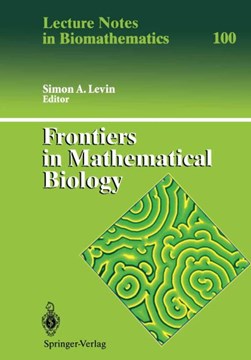-
BROWSE 1000s OF BOOKS IN STOCK
-
FREE DELIVERY ON ORDERS OVER €10
Frontiers in Mathematical Biology
PAPERBACK
Series: See all books in this series
From a mathematical point of view, physiologically structured population models are an underdeveloped branch of the theory of infinite dimensional dynamical systems. We have called attention to four aspects: (i) A choice has to be made about the kind of equations one extracts from the predominantly verbal arguments about the basic assumptions, and subsequently uses as a starting point for a rigorous mathematical analysis. Though differential equations are easy to formulate (different mechanisms don't interact in infinites- imal time intervals and so end up as separate terms in the equations) they may be hard to interpret rigorously as infinitesimal generators. Integral equations constitute an attractive alternative. (ii) The ability of physiologically structured population models to increase our un- derstanding of the relation between mechanisms at the i-level and phenomena at the p-level will depend strongly on the development of dynamical systems lab facilities which are applicable to this class of models. (iii) Physiologically structured population models are ideally suited for the for- mulation of evolutionary questions. Apart from the special case of age (see Charlesworth 1980, Yodzis 1989, Caswell 1989, and the references given there) hardly any theory exists at the moment. This will, hopefully, change rapidly in the coming years. Again the development of appropriate software may turn out to be crucial.
€83.52
Was €104.40

250 Reward Points
In stock online
Extended Range: Delivery in 2-3 working days
Extended Range: Delivery in 2-3 working days
Free Delivery on this item
Any purchases for more than €10 are eligible for free delivery anywhere in the UK or Ireland!
From a mathematical point of view, physiologically structured population models are an underdeveloped branch of the theory of infinite dimensional dynamical systems. We have called attention to four aspects: (i) A choice has to be made about the kind of equations one extracts from the predominantly verbal arguments about the basic assumptions, and subsequently uses as a starting point for a rigorous mathematical analysis. Though differential equations are easy to formulate (different mechanisms don't interact in infinites- imal time intervals and so end up as separate terms in the equations) they may be hard to interpret rigorously as infinitesimal generators. Integral equations constitute an attractive alternative. (ii) The ability of physiologically structured population models to increase our un- derstanding of the relation between mechanisms at the i-level and phenomena at the p-level will depend strongly on the development of dynamical systems lab facilities which are applicable to this class of models. (iii) Physiologically structured population models are ideally suited for the for- mulation of evolutionary questions. Apart from the special case of age (see Charlesworth 1980, Yodzis 1989, Caswell 1989, and the references given there) hardly any theory exists at the moment. This will, hopefully, change rapidly in the coming years. Again the development of appropriate software may turn out to be crucial.

250 Reward Points
Any purchases for more than €10 are eligible for free delivery anywhere in the UK or Ireland!
€83.52
Was €104.40

250 Reward Points
Any purchases for more than €10 are eligible for free delivery anywhere in the UK or Ireland!
Series: See all books in this series
Product Description
From a mathematical point of view, physiologically structured population models are an underdeveloped branch of the theory of infinite dimensional dynamical systems. We have called attention to four aspects: (i) A choice has to be made about the kind of equations one extracts from the predominantly verbal arguments about the basic assumptions, and subsequently uses as a starting point for a rigorous mathematical analysis. Though differential equations are easy to formulate (different mechanisms don't interact in infinites- imal time intervals and so end up as separate terms in the equations) they may be hard to interpret rigorously as infinitesimal generators. Integral equations constitute an attractive alternative. (ii) The ability of physiologically structured population models to increase our un- derstanding of the relation between mechanisms at the i-level and phenomena at the p-level will depend strongly on the development of dynamical systems lab facilities which are applicable to this class of models. (iii) Physiologically structured population models are ideally suited for the for- mulation of evolutionary questions. Apart from the special case of age (see Charlesworth 1980, Yodzis 1989, Caswell 1989, and the references given there) hardly any theory exists at the moment. This will, hopefully, change rapidly in the coming years. Again the development of appropriate software may turn out to be crucial.
Product Details
ISBN9783642501265
FormatPAPERBACK
PublisherSPRINGER (05 June. 2012)
No. of Pages633
Weight1094
Language English
Dimensions 244 x 170 x 42

